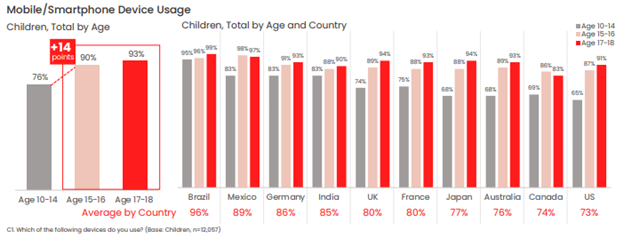“But everyone else has one.”
Those are familiar words to a parent, especially if you’re having the first smartphone conversation with your tween or pre-teen. In their mind, everyone else has a smartphone so they want a one too. But does “everyone” really have one? Well, your child isn’t wrong.
Our recent global study found that 76% of children aged 10 to 14 reported using a smartphone or mobile device, with Brazil leading the way at 95% and the U.S. trailing the global average at 65%.

Our figures show that younger children with smartphones and mobile devices make up a decisive majority of younger children overall.
Of course, just because everyone else has smartphone doesn’t mean that it’s necessarily right for your child and your family. After all, with a smartphone comes access to a wide and practically unfettered world of access to the internet, apps, social media, instant messaging, texting, and gaming, all within nearly constant reach. Put plainly, some tweens and pre-teens simply aren’t ready for that just yet, whether in terms of their maturity, habits, or ability to care for and use a device like that responsibly.
Yet from a parent’s standpoint, a first smartphone holds some major upsides. One of the top reasons parents give a child a smartphone is “to stay in touch,” and that’s understandable. There’s something reassuring knowing that your child is a call or text away—and that you can keep tabs on their whereabouts with GPS tracking. Likewise, it’s good to know that they can reach you easily too. Arguably, that may be a reason why some parents end up giving their children a smartphone a little sooner than they otherwise would.
However, you don’t need a smartphone to do to text, track, and talk with your child. You have alternatives.
Smartphone alternatives
One way to think about the first smartphone is that it’s something you ease into. In other words, if the internet is a pool, your child should learn to navigate the shallows with some simpler devices before diving into the deep end with a smartphone.
Introducing technology and internet usage in steps can build familiarity and confidence for them while giving you control. You can oversee their development, while establishing rules and expectations along the way. Then, when the time is right, they can indeed get their first smartphone.
But how to go about that?
It seems a lot of parents have had the same idea and device manufacturers have listened. They’ve come up with smartphone alternatives that give kids the chance to wade into the mobile internet, allowing them to get comfortable with device ownership and safety over time without making the direct leap to a fully featured smartphone. Let’s look at some of those options, along with a few other long-standing alternatives.
GPS trackers for kids
These small and ruggedly designed devices can clip to a belt loop, backpack, or simply fit in a pocket, giving you the ability to see your child’s location. In all, it’s quite like the “find my” functionality we have on our smartphones. When it comes to GPS trackers for kids, you’ll find a range of options and form factors, along with different features such as an S.O.S. button, “geofencing” that can send you an alert when your child enters or leaves a specific area (like home or school), and how often it sends an updated location (to regulate battery life).
Whichever GPS tracker you select, make sure it’s designed specifically for children. So-called “smart tags” designed to locate things like missing keys and wallets are just that—trackers designed to locate things, not children.
Smart watches for kids
With GPS tracking and many other communication-friendly features for families, smart watches can give parents the reassurance they’re looking for while giving kids a cool piece of tech that they can enjoy. The field of options is wide, to say the least. Smart watches for kids can range anywhere from devices offered by mobile carriers like Verizon, T-Mobile, and Vodaphone to others from Apple, Explora, and Tick Talk. Because of that, you’ll want to do a bit of research to determine the right choice for you and your child.
Typical features include restricted texting and calling, and you’ll find that some devices are more durable and more water resistant than others, while yet others have cameras and simple games. Along those lines, you can select a smart watch that has a setting for “school time” so that it doesn’t become a distraction in class. Also, you’ll want to look closely at battery life, as some appear to do a better job of holding a charge than others.
Smartphones for kids
Another relatively recent entry on the scene are smartphones designed specifically for children, which offer a great step toward full-blown smartphone ownership. These devices look, feel, and act like a smartphone, but without web browsing, app stores, and social media. Again, features will vary, yet there are ways kids can store and play music, stream it via Bluetooth to headphones or a speaker, and install apps that you approve of.
Some are paired with a parental control app that allows you to introduce more and more features over time as your child as you see fit—and that can screen texts from non-approved contacts before they reach your child. Again, a purchase like this one calls for some research, yet names like Gabb wireless and the Pinwheel phone offer a starting point.
The flip phone
The old reliable. Rugged and compact, and typically with a healthy battery life to boot, flip phones do what you need them to—help you and your child keep in touch. They’re still an option, even if your child may balk at the idea of a phone that’s “not as cool as a smartphone.” However, if we’re talking about introducing mobile devices and the mobile internet to our children in steps, the flip phone remains in the mix.
Some are just phones and nothing else, while other models can offer more functionality like cameras and slide-out keyboards for texting. And in keeping with the theme here, you’ll want to consider your options so you can pick the phone that has the features you want (and don’t want) for your child.
Ease into that first smartphone
Despite what your younger tween or pre-teen might think, there’s no rush to get that first smartphone. And you know it too. You have time. Time to take eventual smartphone ownership in steps, with a device that keeps you in touch and that still works great for your child.
By easing into that first smartphone, you’ll find opportunities where you can monitor and guide their internet usage. You’ll also find plenty of moments to help your child start forming healthy habits around device ownership and care, etiquette, and safety online. In all, this approach can help you build a body of experience that will come in handy when that big day finally comes—first smartphone day.
